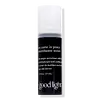What's inside
What's inside
 Key Ingredients
Key Ingredients

 Benefits
Benefits

 Concerns
Concerns

 Ingredients Side-by-side
Ingredients Side-by-side

Water
Skin ConditioningDipropylene Glycol
HumectantPropanediol
SolventCaprylic/Capric Triglyceride
MaskingGlycerin
Humectant1,2-Hexanediol
Skin ConditioningOlea Europaea Fruit Oil
MaskingBakuchiol
AntimicrobialDaucus Carota Sativa Seed Oil
EmollientMoringa Oleifera Seed Oil
EmollientLactococcus Ferment Lysate
Skin ConditioningTanacetum Annuum Flower Oil
MaskingCetearyl Alcohol
EmollientBetaine
HumectantC14-22 Alcohols
Emulsion StabilisingGlyceryl Stearate
EmollientXanthan Gum
EmulsifyingC12-20 Alkyl Glucoside
EmulsifyingPhenylpropanol
MaskingTetrasodium Iminodisuccinate
Levulinic Acid
PerfumingSodium Levulinate
Skin ConditioningGlucose
HumectantAcrylates/C10-30 Alkyl Acrylate Crosspolymer
Emulsion StabilisingTromethamine
BufferingSodium Chloride
MaskingEthylhexylglycerin
Skin ConditioningWater, Dipropylene Glycol, Propanediol, Caprylic/Capric Triglyceride, Glycerin, 1,2-Hexanediol, Olea Europaea Fruit Oil, Bakuchiol, Daucus Carota Sativa Seed Oil, Moringa Oleifera Seed Oil, Lactococcus Ferment Lysate, Tanacetum Annuum Flower Oil, Cetearyl Alcohol, Betaine, C14-22 Alcohols, Glyceryl Stearate, Xanthan Gum, C12-20 Alkyl Glucoside, Phenylpropanol, Tetrasodium Iminodisuccinate, Levulinic Acid, Sodium Levulinate, Glucose, Acrylates/C10-30 Alkyl Acrylate Crosspolymer, Tromethamine, Sodium Chloride, Ethylhexylglycerin
Water
Skin ConditioningNiacinamide
SmoothingGlycerin
HumectantDipropylene Glycol
HumectantPropanediol
SolventDimethicone
EmollientCyclodextrin
AbsorbentMethylpropanediol
SolventSodium Palmitoyl Proline
Skin ConditioningPentylene Glycol
Skin ConditioningCaprylyl Glycol
EmollientPhenoxyethanol
PreservativeSodium Polyacrylate
AbsorbentButyrospermum Parkii Butter
Skin ConditioningPolysilicone-11
Ammonium Acryloyldimethyltaurate/Vp Copolymer
Butylene Glycol
HumectantCannabigerol
Skin ConditioningCannabidiol - Synthetically Produced
AntioxidantSodium Phytate
Camellia Sinensis Leaf Extract
AntimicrobialPalmitoyl Hexapeptide-52
Skin ConditioningPassiflora Incarnata Extract
AstringentDecyl Glucoside
CleansingSea Water Extract
Skin ConditioningN-Prolyl Palmitoyl Tripeptide-56 Acetate
Skin ConditioningWater, Niacinamide, Glycerin, Dipropylene Glycol, Propanediol, Dimethicone, Cyclodextrin, Methylpropanediol, Sodium Palmitoyl Proline, Pentylene Glycol, Caprylyl Glycol, Phenoxyethanol, Sodium Polyacrylate, Butyrospermum Parkii Butter, Polysilicone-11, Ammonium Acryloyldimethyltaurate/Vp Copolymer, Butylene Glycol, Cannabigerol, Cannabidiol - Synthetically Produced, Sodium Phytate, Camellia Sinensis Leaf Extract, Palmitoyl Hexapeptide-52, Passiflora Incarnata Extract, Decyl Glucoside, Sea Water Extract, N-Prolyl Palmitoyl Tripeptide-56 Acetate
 Reviews
Reviews

Ingredients Explained
These ingredients are found in both products.
Ingredients higher up in an ingredient list are typically present in a larger amount.
Dipropylene Glycol is a synthetically created humectant, stabilizer, and solvent.
This ingredient helps:
Dipropylene glycol is technically an alcohol, but it belongs to the glycol family (often considered part of the ‘good’ alcohols). This means it is hydrating and gentle on skin unlike drying solvent alcohols like denatured alcohol.
As a masking agent, Dipropylene Glycol can be used to cover the smell of other ingredients. However, it does not have a scent.
Studies show Dipropylene Glycol is considered safe to use in skincare.
Learn more about Dipropylene GlycolGlycerin is already naturally found in your skin. It helps moisturize and protect your skin.
A study from 2016 found glycerin to be more effective as a humectant than AHAs and hyaluronic acid.
As a humectant, it helps the skin stay hydrated by pulling moisture to your skin. The low molecular weight of glycerin allows it to pull moisture into the deeper layers of your skin.
Hydrated skin improves your skin barrier; Your skin barrier helps protect against irritants and bacteria.
Glycerin has also been found to have antimicrobial and antiviral properties. Due to these properties, glycerin is often used in wound and burn treatments.
In cosmetics, glycerin is usually derived from plants such as soybean or palm. However, it can also be sourced from animals, such as tallow or animal fat.
This ingredient is organic, colorless, odorless, and non-toxic.
Glycerin is the name for this ingredient in American English. British English uses Glycerol/Glycerine.
Learn more about GlycerinPropanediol is an all-star ingredient. It softens, hydrates, and smooths the skin.
It’s often used to:
Propanediol is not likely to cause sensitivity and considered safe to use. It is derived from corn or petroleum with a clear color and no scent.
Learn more about PropanediolWater. It's the most common cosmetic ingredient of all. You'll usually see it at the top of ingredient lists, meaning that it makes up the largest part of the product.
So why is it so popular? Water most often acts as a solvent - this means that it helps dissolve other ingredients into the formulation.
You'll also recognize water as that liquid we all need to stay alive. If you see this, drink a glass of water. Stay hydrated!
Learn more about Water